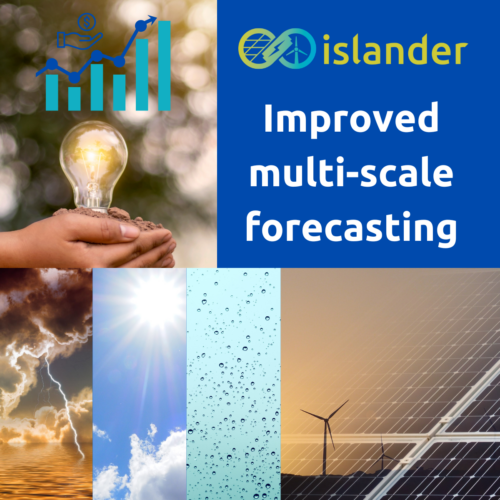
Within the ISLANDER project an improved multi-scale forecasting methodology will be established. This is of central importance for the development of grid management algorithms running the smart IT platform. The forecasting models will rely on recent advances of machine learning in order to deliver high accuracy forecasting data. The different forecasting services to be integrated in the smart IT platform include:
The weather forecasting model will combine the broad forecasting data for the island of Borkum provided by main weather forecast model providers (such as ARPEGE and ECMWF) combined with observational data to achieve the best possible accuracy. Weather conditions have a great impact both on renewable energy generation and on consumption profiles. Given the influence of weather conditions on the other forecasting modules, the weather forecast module will serve as an important foundation. The objective is to develop a 7-days ahead forecast with an hourly granularity for the three weather variables air temperature (at 2m above ground), wind speed (at 10m above ground) and solar irradiance at ground level.
Within the energy price forecasting an artificial neural network (ANN) will be developed to provide an estimation of the energy costs of the day-ahead market considering the hour of the day, the day of the week, the season and the weather conditions. Small and interconnected islands such as Borkum are highly impacted by price energy markets. At an individual level, deferring household or business consumption (specially with electrical vehicles) and valuing their production on the energy market can allow owners of renewable energy production means to make profit on the market. At a global level, anticipating price movements allows a better valuation of flexibility assets on the market and therefore generating higher incomes. The training of the ANN will be performed with data of energy costs and other input data. A posterior phase of refining and learning will be performed during execution of the algorithm to improve the forecasting error. This forecasting module is of central importance for the development of grid management algorithms, as the prediction of energy prices is necessary to optimise the management of energy storage systems.
The macroscopic energy supply and demand forecasting models will provide the supply and demand of the grid assets as a whole. The prediction of the electricity generation and consumption on the island is a key parameter to optimise and plan the use of flexibilities at a global level and therefore decrease the use of non-renewable resources.
These forecasting modules will be complemented by the individual energy supply forecasting modules and the individual energy demand forecasting models.
For more details and insights into each model, you can read the full reports available here. The aim is to present the methods, results, and conclusions reached for the 3 forecasts (weather forecasting model, price forecasting model and macroscopic energy supply and demand forecasting models).
Follow us